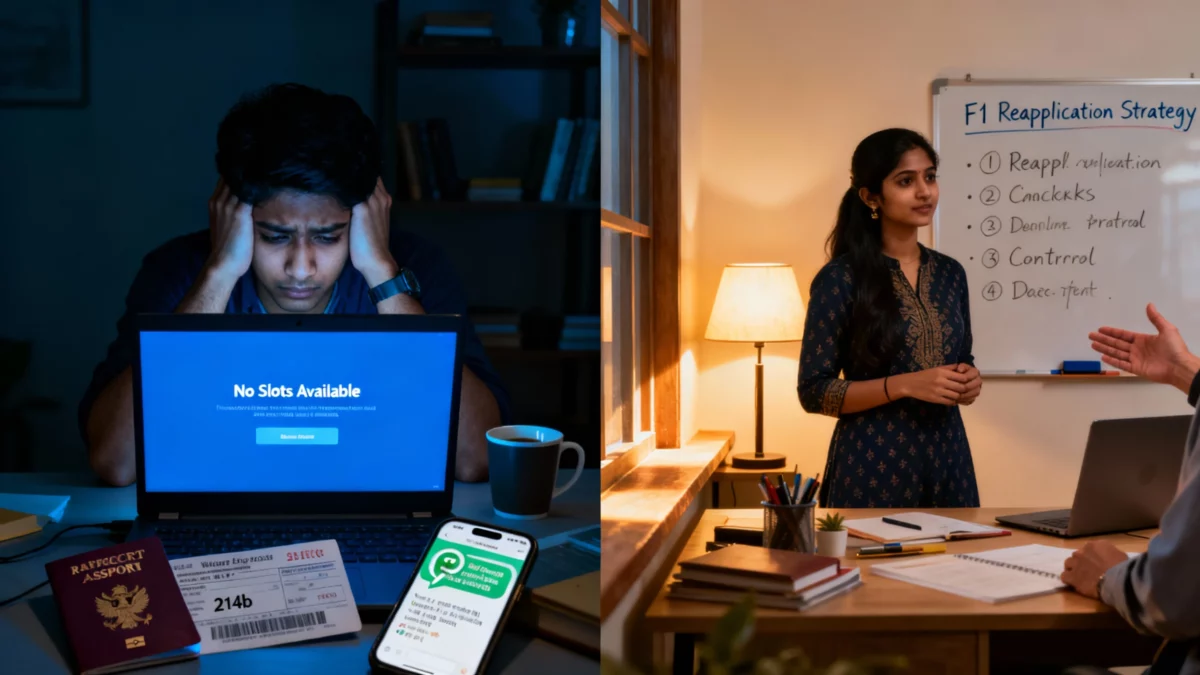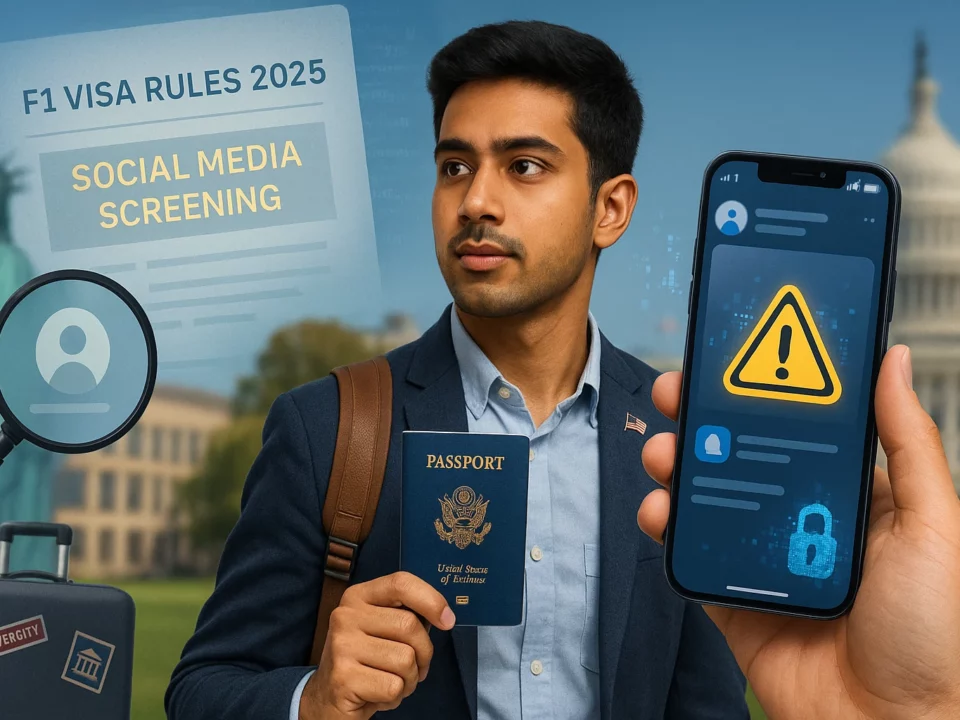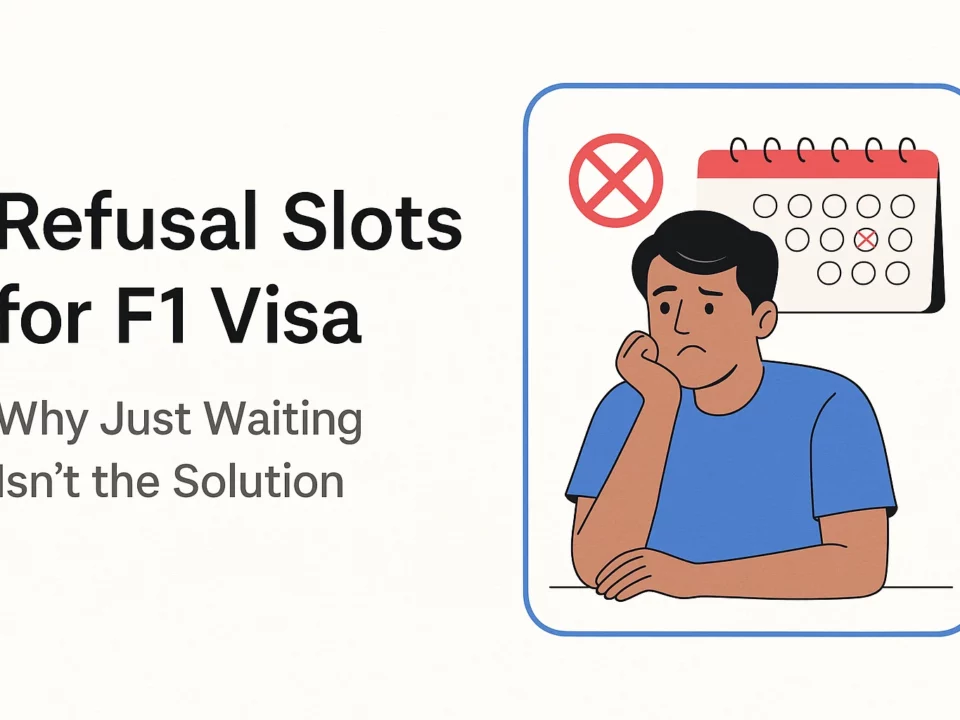F1 Visa Slots Spring 2026: The Lesser Known Story

Estimated reading time: 15 minutes
When Desperation Meets Preparation (Or Lack Thereof)
It’s mid-November 2025, and across India, two very different groups of students are obsessively checking the USVisaScheduling website. First, there are first-time applicants with fresh I-20s, watching F1 visa slots for spring 2026 tick away, nervously awaiting interview dates. Second, and more importantly, there are rejected students from Fall 2025 (and some from even earlier cycles) refreshing the page every 10 minutes, desperately hoping for a “refusal slot” to appear.
Here’s the critical question: If you’re in the second group, desperately waiting for F1 visa slots spring 2026, what you’re about to read might frustrate you. However, it needs to be said—and said clearly: Getting a refusal slot after rejection is NOT the solution to your problem.
Your preparation is.
This distinction matters more than you realize. In fact, understanding this difference could mean the difference between approval and another devastating rejection.
Table of contents
- When Desperation Meets Preparation (Or Lack Thereof)
- The Annual Phenomenon Nobody Talks About
- The Real Problem: You’re Looking for a Slot. You Need to Look for Preparation.
- The Case Study: Praveen Shetage, Maharashtra
- The Uncomfortable Truth About F1 Visa Interviews
- The Desperation Trap: Why Rushing to Your Next Interview Could Cost You Again
- The Evidence: Slot Availability ≠ Approval Likelihood
- What Went Wrong With Praveen’s Application (And What’s Going Wrong With Yours Too)
- The Slot Will Open. Will YOU Be Ready?
- The Uncomfortable Truth About 2025-2026 F1 Visa Reality
- The Harsh Math: Refusal Slots Opening December = Peak Desperation
- What Needs to Change: Your Entire Approach to F1 Visa
- The Path Forward: Before You Even Think About Refusal Slots
- For Students Like Praveen: There’s Still Hope
- Final Thought: The Desperation Is Real, But So Is The Solution
The Annual Phenomenon Nobody Talks About
Every year, without fail, like clockwork, the same cycle repeats itself—and most students don’t see it coming.
August-October: Slots are abundant. First-timers and prepared reapplicants easily book interviews without stress.
November: Panic sets in. Slots start tightening as demand increases exponentially.
Early December-January: The refusal rush begins. Specifically, mid-December to early January, consulates strategically open “refusal slots” to accommodate rejected students reapplying. Yet, here’s the problem—these limited slots fill in HOURS, not days.
The Result: Thousands of rejected students desperately competing for limited refusal slots for spring 2026, refreshing the page 24/7, setting alarms at 2 AM, losing sleep over a slot that might not even solve their real problem.
And then… many of them get rejected AGAIN. Even after all that desperation. Even after finally booking that coveted refusal slot. Even after weeks of anxiety.
Why does this happen repeatedly? The answer is simple, yet almost nobody understands it: They’re chasing the slot when they should be chasing the actual solution.
The Real Problem: You’re Looking for a Slot. You Need to Look for Preparation.
Let us tell you about Praveen Shetage. His story is one we see over and over at Bluehawks, and it perfectly illustrates the tragedy that’s unfolding for hundreds of rejected students right now—students who are desperately seeking F1 visa slots for spring 2026 without understanding what really went wrong.
The Case Study: Praveen Shetage, Maharashtra
Profile:
- Undergraduate: B.Tech in Computer Science (June 2025)
- University: Long Island University, Brooklyn Campus, New York
- Program: Master’s in Computer Science
- Current Status: Rejected, waiting for refusal slots, unsure what went wrong
The Timeline:
- Applied for Fall 2025 → Got slots in September
- Attended interview at Kolkata Consulate → REJECTED
- Now desperately waiting for Spring 2026 F1 visa slots (refreshing the page multiple times daily)
The Interview (as it happened):
The Visa Officer asked only 3 questions:
- “You are going to Long Island University for master’s?”
- “Why did you choose this university?”
- “What other universities have you applied to?”
Praveen provided generic answers. Textbook responses. (though he did his research with AI plus his existing consultant helped him with practice questions)The kind of generic answers that any student could give. No personalization. No insight. No conviction.
But here’s the critical part and this is where most rejected students miss the point: The rejection had absolutely nothing to do with how he answered these three questions.
In fact, the rejection was already decided. Before his interview even started. Before he sat across from the visa officer. Before any questions were asked.
The Hidden Red Flag: DS-160 Edition
When we at Bluehawks deep-dived into Praveen’s DS-160 form during our refusal analysis, we found it immediately. Moreover, this finding changed everything about how we approached his case:
Education Section – Final Education:
“I completed my Btech in Computer Science in June 2025”
That’s it.
To a US Visa Officer, this single vague sentence reads like: “I’m an average student with absolutely no standout achievement, and frankly, I don’t even have the attention to detail to proofread my own application.”
Consequently, this single paragraph—this incomplete, vague, was likely the nail in the coffin before Praveen ever stood across from the VO. Therefore, it didn’t matter how confident he sounded or what answers he gave to those three questions.
Read: DS-160 Form Guide 2026: Former Officer Reveals Secret
The Uncomfortable Truth About F1 Visa Interviews
Most people including most rejected students think F1 visa approval depends on how well you perform in the interview itself. They believe that confidence is key. They think that if you don’t stutter, if you maintain eye contact, if you smile—you’ll get approved.
This thinking is dangerously wrong. In fact, it’s one of the biggest misconceptions in the F1 visa process.
Here’s the reality: 80% of your interview outcome is determined BEFORE the interview starts. This isn’t speculation or opinion—this is how visa officers actually work.
The Visa Officer has already made up their mind based on:
✗ Your DS-160 form – Typos, vague answers, inconsistencies scream lack of seriousness
✗ Your academic credentials – Are they strong enough for your stated university?
✗ Your financial situation – Can you ACTUALLY afford this, or are you hiding something?
✗ Your Narrative – Is your story believable or generic like everyone else’s?
✗ Your university choice – Does it genuinely match your academic profile?
✗ Your work experience – Does your background logically support your stated goals?
The interview? The interview is confirmation, nothing more. The VO is looking for a reason to reject you. If you give them even one solid reason, the decision is made. If you fail to give them evidence that you deserve approval, the decision is still made.
Praveen’s DS-160 said: “I’m unprepared, unserious, and completely undifferentiated. Just like 50,000 other students sitting in that waiting room right now.”
The VO didn’t need to hear more. The decision was essentially made when that vague sentence was submitted.
The Desperation Trap: Why Rushing to Your Next Interview Could Cost You Again
Right now, in mid-November 2025, rejected students like Praveen are doing what they always do when facing rejection: They’re waiting for F1 visa slots spring 2026 to open. Meanwhile, they’re panicking. Additionally, they’re studying a few mock interview questions. Moreover, they’re losing sleep.
And when those refusal slots for spring 2026 open in mid-December, here’s what will happen: They’ll panic-book the first available date. They’ll dread the interview for 2-3 weeks. Eventually, they’ll study a few mock interview questions. Yet, they’ll walk into that interview thinking the problem was their confidence, their English, their nervousness in the first attempt.
They’ll get rejected again. Many of them. Statistically, approximately 40-50% of rejected students who reapply without properly fixing the foundation will face rejection again.
Why? Because they’ve missed the entire point. Furthermore, they’re making the same fundamental mistakes. They haven’t addressed what actually caused the rejection in the first place.
The Slot Is Not Your Problem
Getting an F1 visa refusal slot used to be relatively easy. 2-3 years ago, rejected students could reapply within a month and often get approved. The bar was lower. The competition was less fierce. The VO’s standards were different.
Not anymore. In fact, 2025 marks a turning point in F1 visa approvals.
In 2025, F1 visa rejections are at their highest levels for Indian students in a decade. The consulates are stricter. The VOs are more skeptical. The competition is exponentially fiercer. Therefore, what worked three years ago no longer works today.
Getting a refusal slot in 2025-2026 is MUCH harder than it was before. Consulates open these f1 visa refusal slots for limited windows, and they fill up INSTANTLY. Moreover, even if you DO get that slot, if your preparation is poor, you’ll just be wasting it.
You’ll be one of thousands of desperate students taking a slot away from someone who might actually be ready. And most importantly, you’ll get rejected again. Consequently, you’ll waste another opportunity and fall further behind.
The Evidence: Slot Availability ≠ Approval Likelihood
Fact: Refusal slots for spring 2026 will open in mid-December through early January.
Also Fact: The number of rejected students waiting for these F1 visa slots for spring 2026 (in 2025) is 60% higher than it was in 2024.
And Yet Fact: Refusal approval rates (students approved on their second attempt) have DROPPED by 15% year-over-year.
This creates a troubling equation. More students competing for fewer slots, yet fewer of them getting approved even with the second chance. What does this tell us? The culprit is clear: Poor preparation. Rushing into the interview without fixing the fundamental issues. Therefore, you can see why simply getting a slot is not enough anymore.
The statistics don’t lie: Students who get refusal slots spring 2026 without proper preparation have roughly the same 30-40% rejection rate as first-timers.
Students who get refusal slots WITH proper preparation have a 85-95% approval rate.
That’s not luck. That’s preparation.
What Went Wrong With Praveen’s Application (And What’s Going Wrong With Yours Too)
Let’s break down Praveen’s fundamental mistakes. Specifically, these are errors we see repeatedly. If you’re a rejected student waiting for F1 visa slots for spring 2026, you probably share at least 3 of these critical mistakes:
Mistake 1: Vague, Incomplete DS-160 Responses
What Praveen Wrote:
“I complete my Btech in Computer Science in June 2025”
What He Should Have Written:
“I completed my B.Tech in Computer Science from [University], graduating in June 2025 with a 3.8/4.0 GPA. My specialization was in AI/ML, with relevant coursework in Neural Networks, Machine Learning, and Data Structures. I completed a capstone project on [specific project] that won [award/recognition], and interned at [company] as a Software Engineering intern during Summer 2024.”
+ How this whole thing is associated with the program I am seeking to pursue in the US
+ How this would help me back in my home country/what would be my perks of coming back to my home country
The difference? One tells the VO: “I’m average and careless.” The other says: “I’m serious, accomplished, detail-oriented, and worth approving.”
Mistake 2: Generic University Choice Without Research
What Praveen Likely Thought:
“Long Island University? It’s a decent school, offers MS in CS, has available seats for internationals. Good enough.”
What He Should Have Done Instead:
Research LIU’s specific program. Know the faculty. Know the curriculum. Know what makes it distinct. Know why you chose it specifically over 15 other universities offering the exact same degree.
A VO will ask: “Why this university?” and Praveen gave a generic answer because his research was generic. Therefore, the VO suspected he wasn’t genuinely interested—just desperate.
Mistake 3: No Distinction in Academic/Professional Background
The VO’s Silent Question: “What makes this student special?”
If the answer is “Nothing special,” rejection is highly likely. In fact, it becomes probable.
Praveen was an “average” CS student (no distinction mentioned in his DS-160). He had no standout projects. No internships mentioned. No leadership experience. To the VO, he was 1 of 50,000 similar students applying for MS in CS that semester. Moreover, he was indistinguishable from every other applicant.
Mistake 4: Waiting for the Interview to Prepare
Praveen’s critical mistake was thinking: “I’ll prepare after I get the interview date.”
By then, it’s far too late. The VO has already decided based on your DS160 narrative. The interview is just confirmation of what they already think.
By the time you get the interview date (usually 2-3 weeks later), you should have already completed:
- Complete DS-160 review (100+ checkpoints)
- SOP rewrite (3-4 iterations minimum)
- Document review (birth certificate, mark sheets, financial statements, etc.)
- Mock interview prep (10+ practice interviews)
- University research (know their website inside-out)
Mistake 5: Not Understanding the VO’s Mindset
The VO is not trying to approve you.
This is the hardest truth for rejected students to accept. Furthermore, it requires a complete mindset shift. The default assumption should be:
“The VO will reject me unless I give them a compelling reason to approve me.”
Not: “The VO will approve me unless I give them a reason to reject me.”
These are fundamentally different mindsets. Moreover, they lead to completely different outcomes.
If you’re in the “they’ll approve unless I mess up” camp, you’re already in trouble. The VO’s job is to protect US interests. Visa fraud is real. Overstay is real. They’re skeptical by default. Therefore, you need to overcome that skepticism with evidence.
You need to overcome that skepticism with evidence. Strong narrative. A compelling story. Academic credentials that match your program. Financial proof that’s beyond reproach. A believable career trajectory.
Praveen had none of these. Consequently, his DS-160 screamed: “I’m unprepared.” That’s all the VO needed to know.
The Slot Will Open. Will YOU Be Ready?
Here’s what’s going to happen in the next 6 weeks with F1 visa slots for spring 2026:
Mid-December 2025: Consulates announce refusal slot availability.
First 12 hours: 70% of available slots get booked immediately.
Desperate students: Finally get a slot in late December or early January.
Late January 2026: These students attend their interviews… and statistically, a significant portion (40-50%) get rejected again.
Why? Because they did the same thing Praveen did: They focused on GETTING the slot instead of actually PREPARING for the slot. Therefore, their preparation level hasn’t improved. Moreover, their documents haven’t been fixed.
The slot is not the prize. The approval is. Furthermore, the only thing that guarantees approval is proper preparation.
The Uncomfortable Truth About 2025-2026 F1 Visa Reality
We need to be honest with you—all the way.
Getting a US F1 visa in 2025-2026 is harder than it’s ever been in the last decade. The rejection rates for Indian students are at historic highs. The competition is fiercer than ever. The VOs are stricter. The standards are higher.
Generic preparation will not cut it anymore. In fact, it will likely result in another rejection.
Going into an interview thinking “I’ll just be confident and it’ll be fine” is naive. Moreover, it’s dangerous to your educational dreams. Many students are confident. Many students are well-spoken. Many students have good academics. That’s the baseline now, not the differentiator.
What actually matters:
- Flawless documentation with zero errors
- Compelling, specific narrative (not generic)
- Genuine, thorough research about your university and program
- Financial proof explanation that’s beyond reproach
- A story that makes the VO think “Yes, THIS student belongs in the US”
Praveen had none of these. Therefore, he got rejected. Now, he’s in the same stagnant stage as hundreds of thousands of rejected students: desperately waiting for refusal slots for spring 2026 while missing the real problem entirely.
The Harsh Math: Refusal Slots Opening December = Peak Desperation
The 2025-2026 Refusal Slot Reality:
| Metric | Number |
|---|---|
| Rejected Indian F1 students (Fall 2025) | ~150,000+ |
| Estimated refusal slots to open (Dec-Jan) | ~15,000-20,000 |
| Desperate students competing per slot | ~8-10 |
| Students who get rejected AGAIN without prep | ~40-50% |
Translation: Even if you get a refusal slot for spring 2026, your chances of approval WITHOUT proper preparation are no better than a coin flip—roughly 50-50.
However, if you DO the deep work—the DS-160 rewrite, the narrative refinement, the mock interviews, the actual interview simulation, your chances jump dramatically to 75-85%.
That’s the critical difference between casual preparation and serious, expert-guided preparation.
Praveen took the casual route. He paid the price.
What Needs to Change: Your Entire Approach to F1 Visa
This is where we’re going to be most direct, because this is where it matters most to your future:
Old Thinking (Doesn’t Work Anymore):
- “I’ll get a slot and wing the interview”
- “Being confident and likeable is enough”
- “My good academics speak for themselves”
- “I’ll study mock questions the week before”
- “The VO wants to approve people anyway”
New Thinking (2025-2026 Reality):
- “I need to be absolutely prepared BEFORE I book ANY slot”
- “Confidence means nothing without documentary evidence”
- “Academics matter, but my story matters more”
- “I need 20+ mock interviews BEFORE the real one”
- “The VO is skeptical until PROVEN otherwise”
The students getting approved right now understand this new reality. They’ve made this mental shift. Consequently, they’re succeeding.
Students like Praveen, who are waiting for F1 visa slots spring 2026 without this understanding, do not succeed. In fact, many face rejection again.
The Path Forward: Before You Even Think About Refusal Slots
If you were rejected in Fall 2025, understand this clearly: Your path forward requires strategic thinking, not desperation.
1. The slot is not your barrier. Preparation is.
Getting a refusal slot is challenging, yes. However, it’s the second problem, not the first. Your first problem is that your application wasn’t strong enough to get approved the first time. Therefore, focus there first.
2. Most rejections happen before the interview.
Your DS-160, your narrative, your documents, your university research—these matter exponentially more than how you sound in the interview room. In fact, they determine 80% of the outcome.
3. You need expert help. Seriously.
We say this not as a sales pitch but as evidence-based fact: Students who work with experienced visa consultants have significantly higher approval rates on reapplication. Why? Because they fix the foundation, not just practice the interview. Moreover, they avoid repeating the same mistakes.
4. Rushing to your next interview is a trap.
When F1 visa slots for spring 2026 open in mid-December, the desperation will be real. You’ll feel the urgency. Yet, only book if you’re actually prepared. Otherwise, you’re just wasting a slot and setting yourself up for another rejection. Furthermore, you’re wasting 4-6 months of your life waiting for a slot that didn’t help.
5. Your story needs to be specific, not generic.
“I want to study CS because it’s my passion” is what 50,000 other students say. Furthermore, it says nothing distinctive.
“I want to specialize in AI/ML because I built [specific project] that did [specific thing], and now I want to [specific career goal]” is what almost nobody says. Moreover, this is what VOs remember and believe.
For Students Like Praveen: There’s Still Hope
If you’re currently rejected and waiting for refusal slots spring 2026, this isn’t doom and gloom. There’s a clear, strategic path forward.
What worked for students who got approved on reapplication:
- They identified the real reason for rejection (not just guessing)
- They fixed the foundation (DS-160, Narrative) with expert help
- They prepared intensively (mock interviews with ex visa officers)
- They changed their mindset (skepticism until proven otherwise)
- They waited until they were ready (didn’t rush into the next slot)
Praveen’s story isn’t over. However, his next interview needs to be completely different from his first one. Furthermore, it requires a fundamental rebuild, not just practice.
His DS-160 can’t say “I complete my Btech in Computer Science in June 2025” ever again. Instead, it needs to showcase achievement, specificity, and excellence.
His narrative can’t be generic. Consequently, it needs to be so specific that the VO thinks “Only THIS student could write this. This student is genuinely committed to this program.”
His interview can’t be answered with generic responses. Furthermore, he needs to have done so much research and preparation that every answer sounds like it could only come from someone who’s truly serious about Long Island University and his specific career path.
This is possible. However, it requires a fundamental shift from where he (and thousands of rejected students) are right now.
Final Thought: The Desperation Is Real, But So Is The Solution
Every year, students like Praveen go through this cycle: Rejection → Desperation → Refusal slot search → Another rejection → Desperation intensifies. Moreover, this cycle repeats. It’s tragic. It’s preventable. And it’s happening right now to hundreds of thousands of Indian students.
The solution isn’t better luck with slot timing. Therefore, the solution is better preparation before you ever book the slot.
Slots will open. In fact, mid-December will come. Refusal slots will be announced. But preparation opens doors. Focus on the latter, and the former becomes irrelevant.
The desperation is real. However, the solution is also real. But here’s the critical part: You need to act NOW, before you even search for F1 visa slots for spring 2026.
This article is written for every student currently refreshing the usvisascheduling website every 10 minutes, hoping for a refusal slot to appear.
It’s not about luck. It’s about being ready.
Are you?
💬 Chat with our 24/7 chat support team, just tap on that WhatsApp button on the right bottom of your screen 👉



